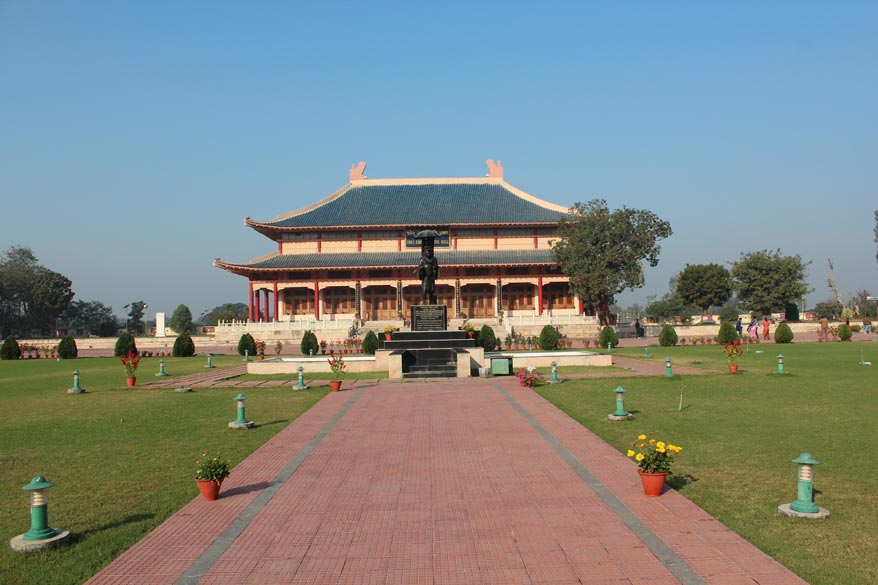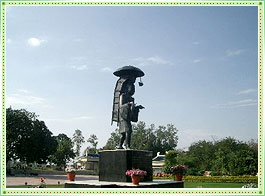Nalanda, an ancient center for higher learning, is located around 55 miles south east of Patna in the state of Bihar. Nalanda is considered as one of the oldest and great universities in the world. Founded in the 5th century BC Nalanda was one of the world’s great universities and an important Buddhist centre until it was attacked by marauding Afghans in the 12th century. The history of Nalanda dates back to the time of Lord Buddha and Mahavir. The place was named after the terms ‘Nalam’ meaning ‘Lotus’ and ‘da’ that means ‘to give’.There is also a fabulous legend behind the name Nalanda, which narrates how this village got its name. It goes like this that the place where the monastery was going to be constructed was the abode of a serpent and while digging the foundation the serpent got injured. The clairvoyants of that time observed that the monastery that would have been constructed in that place would be renowned for a long. Later this Monastery turned to be a great institution of knowledge, whose unparallel credentials gave it a unique seat in the entire history of the nation. Nalanda is also known as the birth place of a follower of Lord Buddha, named Sariputra. Lord Buddha is believed to have visited this place several times during his lifetime.The head quarter of knowledge and learning, Nalanda is renowned for a culture and tradition in ancient India.
How to reach here:
By Air: Lok Nayak Jayaprakash airport at Patna is the nearest airport, which is 78 km away from Nalanda.
By Rail: Rajgir is the nearest railhead to the place, which is about 12 kilometres away from Nalanda. The station is connected to the several cities of India.
Best time to visit: October to March.
Languages spoken: Hindi.
Must eat: Khaja, Kasar.
Famous Restaurant: Nalanda Book Cafe.
Places you must visit:
The Nalanda University was built in 5th century BC and is recorded as the earliest university of world. It is spread over an area of 14 hectares and has been built with red bricks in the Kushana architectural style. The favorite disciple of Lord Buddha namely Sariputra died preaching at this very place. In 3rd century BC, Ashoka built a grand stupa in honor of Sariputra. The infrastructure of Nalanda University has 3 to 6 storeys along with a college of fine arts endowed by the Gupta Emperor, Kumaragupta, a library comprising of a huge collection of over nine million volumes and 300 apartments. Rows of monasteries, hostels and classrooms form a large part of the structure of this university providing a strong impact of the Pala dynasty. It has a total of one thousand teachers and ten thousand students in its portals.The university used to house 10000 students and 2000 teachers and had dormitories for students according to their status. Somewhere among the ruins, there are also structures like stupas, monasteries, temples, chaityas, etc. Certain remains have also been excavated from the ruins of this university, which includes a stairway, decorated panels, stupas, dormitories of monks and students, lecture halls etc. The most significant monuments found from here are the monasteries and chaityas. Remains of a temple depicting household scenes, dancers and floral designs are also seen at the site of this university.





The Surya Temple also known as Surajpur Baragaon is another popular temple attraction of Nalanda situated near the Nalanda University. This temple is dedicated to the Sun God and the sun worship called the ‘Chhath Puja’ is held here twice every year in ‘Vaishakha’ and ‘Kartika’ months of Hindu calendar. This temple comprises idols of many Hindu gods and goddesses combined with some of the Buddhist deities. The main attraction at this temple is the five feet high idol of Goddess Parvati placed here.

Nav Nalanda Vihar also known as Nava Nalanda Mahavihara is a significant educational institute of Nalanda, which was set up in 1951 by the Bihar Government, near the Lotus Pond. This institute was established with the aim of bringing back the status of Nalanda as an educational institute. The main teachings of this institute include Pali language and aspects of Buddhism for Indian and foreign languages. Several research and studies are done by the Indian and foreign students at this university on Pali language and Buddhism. Foreign countries that are an active part of this institute include Sri Lanka, Japan, Korea, Tibet and Bhutan.
Bihar Sharif is a significant center of Muslim learning built in the 13th century. This place is the erstwhile capital of the Pala rulers and portrays the picture of a bustling town of a rich history. It also displays remains of medieval Islamic architecture of the Gupta empires in the form of numerous tombs and mosques.The most important attraction in the place is the tomb of Makhdum Shah Sharif-ud-din, who was a renowned Muslim saint. Due to this tomb, Bihar Sharif is also a popular Muslim pilgrimage center Other attractions around this tomb include a Buddhist Vihara, a prison of the time of King Jarasandhan and few other shrines.


Kundalpur is the birthplace of the most famous disciple of Lord Mahavira namely Gutamswamiji. It is said that Lord Mahavira has visited this place several times to impart his religious teachings. This place was also a Buddhist monastery during the rule of King Kumar Gupta, between the years of 424 BC and 454 BC. It is also home to Kundalpur Teerth Temple, which is maintained by Shri Jain Shwetambar Bhandar.




The Hiuen Tsang Memorial Hall has been built in the memory of known Chinese Scholar, Hiuen Tsang. Hiuen Tsang is said to have resided in this very same place for over 12 years during his tour of India in the 7th century AD. He also studied yoga here under the guidance of Acharya Shil Bhadra.The architecture and grandeur of this hall provides a reminder of the Nalanda University. This memorial hall houses the famous writings of Hiuen Tsang that provides valuable information about medieval India. The writings present here have also formed the base of the educational set-up of Nalanda.



The Nalanda Archaeological Museum was established in 1971 and comprises the relics of the ancient Nalanda University. It provides an insight of the Pala Art, which is an example of the creative arts taught at the Nalanda University. Its sculptures showcase the attires, ornaments and societal features of the Pala Period. The sculptures, manuscripts, seals and statues portrayed here are regarded as the finest display of the people and culture of ancient Indian society.This complete museum is divided into four main galleries housing 13463 antiquities that have been excavated from 349 sites. Most of these artefacts date back to the time between 5th and 12th century AD and reflect Buddhist, Jain and Hindu ideologies. The statues kept in this museum are of stucco, bronzes, stone and terracotta, but majority are of Basalt stone. The main hall at this museum includes 16 sculptures of Trailokya Vijay, Maitreya, Buddha in Varad, Dharmachakra and Bhumisparsh postures, Bodhisattva Avalokiteshvara, Parshvanath and Nagaraj sculptures etc.Khasarpana, Vagesvari, miracle of Saraswati, Surya, Lakshmi, Ganesh, Shiva-Parvati, Kuber, Vaishali-miracle, Buddha in varad mudra and Rishabhanath are few of the 57 images and sculptures present in the first gallery of this museum.


The Stupa of Sariputra is one of the remarkable excavations present amongst the ruins of Nalanda University. Sariputra was the favourite disciple of Lord Buddha who became a celebrated Arhat after attaining salvation. The structure of this stupa has a pyramidal shape with towers above the whole complex. The entire site of this stupa is surrounded by pillared structures that provide a grand sight during the heydays of Nalanda.This stupa was a result of seven consecutive accretions and is protected by seven layers of constructions surrounding it. The corner looms and neighbouring stupas at the place are ornamented with niches of Bodhisattvas and different events of Buddha’s life.

No comments:
Post a Comment